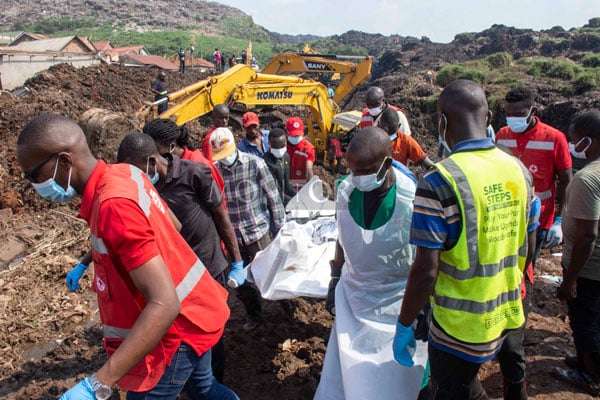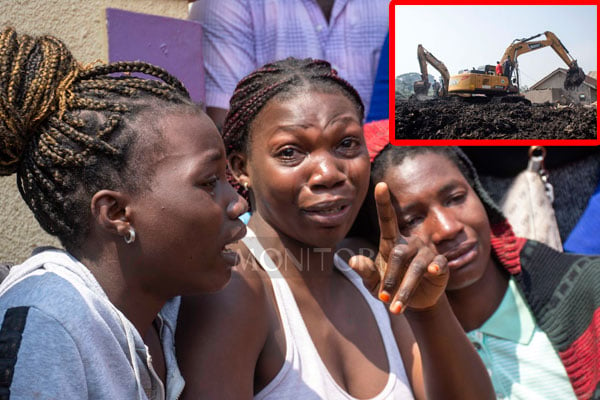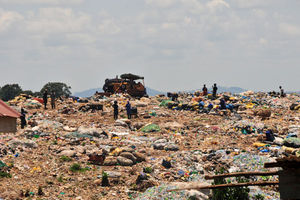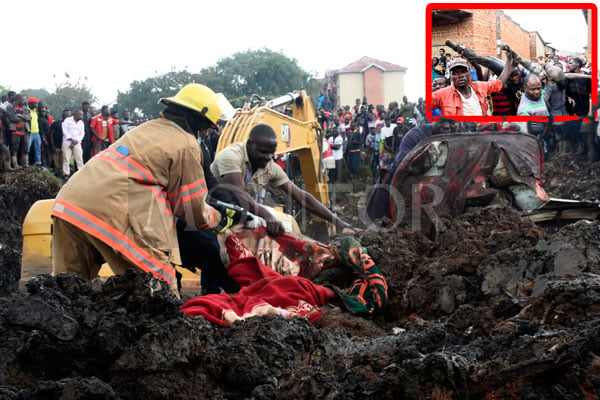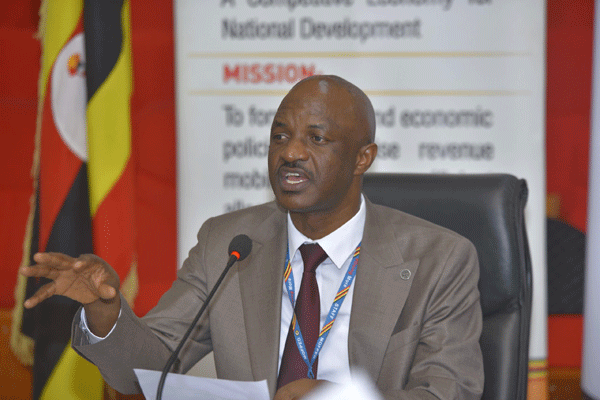
Police at the site of the Kiteezi landfill collapse in Wakiso District on August 11, 2024. The landfill collapsed on August 10. PHOTO/ ISAAC KASAMANI
The putrid smell from the garbage dumpsite in Kiteezi, Wakiso District, hits the nostrils from far – at least a kilometre or two away. Then it begins to suffocate as one draws near. Flies buzz around. Marabou storks (kaloli), with gigantic steps scavenge. Dozens of people scour through the garbage looking for valuables to be recycled.
Many with mental challenges find the heap a haven for their lives: food site, sleeping platform and area for answering the call of nature. Leachate from the decomposing solid waste flows in greenish and dark hues to contaminate open water sources besides seeping to pollute underground water.
Yet, in the immediate neighbourhood are homes living at peace.Or, at least, that is what they look like. Welcome to Kiteezi, the sprawling dumpsite in Kasangati Town Council, Wakiso District, where disaster that has been in the waiting for nearly two decades – from when the landfill was first condemned in 2005 – struck on Saturday.
So, what was the situation before a mass of the waste heap broke on the back of structural failure to bury residents, houses and animals alike?
Established in Nangabo Sub-county about 28 years ago, present-day Kiteezi landfill has been receiving an estimated 1,300 tonnes of the 2,500 tonnes of waste daily from the Kampala Metropolitan Area, according to local leaders.
Living near the landfill is a nightmare. Locals are highly at risk of contracting hygiene-related diseases and other health complications. Some residents have been forced to relocate the neighbourhood.
Mr Patrick Kasolo, a resident of Lusanja-Kiteezi, said ever since he became a resident in 2010, the place has never been a home for his family because of the stench emanating from the landfill.
“During the rainy season, the smell is at its highest point, it stinks a lot and the house flies are all over the place. The marabou stork damage our rooftops. Remember garbage collectors dump even dead animals and all the rotten waste. The birds carry this waste to our homes,” Mr Kasolo says.
He adds that his children have contracted diarrhoea and other complications several times.
“I spent Shs120,000 treating my children in March. It is difficult staying here, especially during the rainy season when the landfill has a lot of rotten material,” he says.
Mr Charles Mukisa, the chairperson of Kitetika Village, which is four kilometres away from the landfill, says: “We have a trench that passes here and connects directly from the landfill. Most times when it rains, you cannot breathe well or eat anything. The sewage gives us sleepless nights.”
He adds that several locals have written to his office to have the landfill relocated, but “higher authorities have given us a deaf ear’’.
Despite the health-related challenges, Mr Kasolo said the landfill has employed several people.
“Many people, especially women are working from the landfill and they are earning money. People sort plastics and other valuables and they sell,” he says.
Mr Kasolo, who also works as an engineer at Aquila Recycling Plant in Kiteezi, adds that there is need for the government to put in place programmes that will train the locals in waste management.
“Every household should be able to sort out bio-degradable and non-biodegradable waste. Kampala Capital City Authority (KCCA) also has a plan to set up a landfill in Ddundu, Mukono,’’ Mr Kasolo says.
Mr Samson Wandera, a garbage vendor in Kireka, who has scavenged plastics in Wakiso District for three years, says the business has helped him fend for his family.
“We sell a kilogramme of plastic bottles for between Shs400 and Shs700 per kilogramme, depending on the quality. The biggest challenge we have is everybody thinks we are mentally ill. But we contribute to collecting plastics from the environment,’’ he says.
Mr Esau Mpoza, the Wakiso District environment officer, was unavailable to speak for this article.
Dr Daniel Okello, the director of public health and environment at KCCA, says ending the garbage and plastic mess needs a united effort by all stakeholders.
“In my office, I spend up to Shs14b of taxpayers’ money on ideally bad habits [public disposal] of kaveras (polythene bags) and collecting rubbish/garbage. I also manage the city abattoir. There are animals that die due to eating kaveras. The farmers keep making losses,’’ he said.
The plastic and waste menace in Kiteezi is similar to the ravages of a dumping site at the railway line in Kireka, a suburb east of Kampala. The site is 40 metres from Kireka Palace Primary School and 200 metres from Mandela National Stadium (Namboole).
More than 50 business premises are close to the filthy area, including a fuel station and a building being erected in a wetland, according to the National Environment Management Authority (Nema).
At the site, children and women actively engage in sorting plastics and other non-biodegradable materials such as disposable bags, supermarket bags, plastic containers, water bottles, and metal cans.
The administration of Palace Junior School Kireka declined to comment on the matter, saying it is sensitive.
“We would not like to be involved in this issue. Kiira Municipal authorities and the railway line management is handling it,’’ a man, who preferred to remain anonymous, said in a telephone call while responding to our emails to the school.

